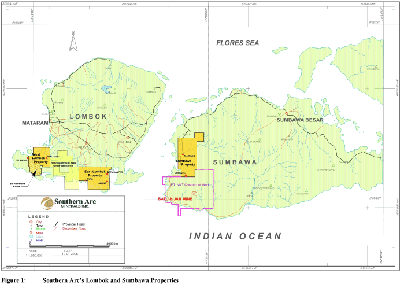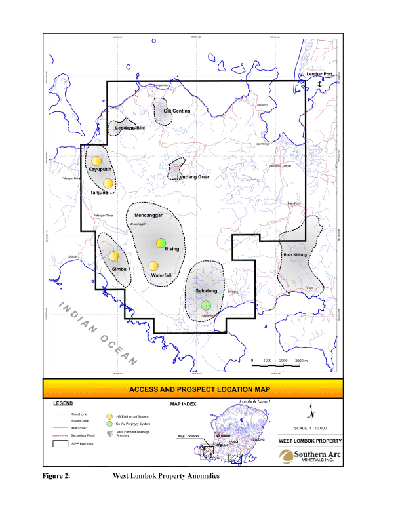Southern Arc Completes Acquisition Agreement With Newmont
Vancouver, B.C.:Southern Arc Minerals Inc. (TSX Venture: SA) is pleased to announce that it has completed an agreement with PT. Newmont Nusa Tenggara (NNT), a subsidiary of Newmont Mining Corporation, regarding a 8,860 ha property (known as Block 1) which is contiguous with the western boundary of SA's current Lombok Island SIPP license. Lombok Island is located immediately west of Sumbawa Island, which hosts Newmont's gold-copper porphyry Batu Hijau Mine having a reported 2005 production of 760,000 oz of gold and 700 million pounds of copper (see Figure 1).
The acquisition was completed through a relinquishment by NNT of Block 1 and a subsequent expansion by SA of its current Lombok SIPP license to include the Block 1 area. The terms of the agreement include granting NNT a 2 percent NSR on any mineral production from the area covered by Block 1 together with a right of first refusal should SA wish to introduce a new partner into any development within the area originally covered by Block 1.
Block 1 was held by NNT under a fourth generation Contract of Work during the period 1985-2005. Block 1 is located approximately 1.5 hours drive from the provincial capital of Mataram and can be accessed through a good network of logging and local government roads.
Initial drainage sampling by NNT throughout Block 1 outlined 11 contiguous streams with anomalous Au- Ag±Cu±As geochemistry covering an area of approximately 50 km2. Newmont's exploration activities up to 1998 focused on the delineation of both precious metal and porphyry copper style mineralization and resulted in the definition and partial drill testing of a number of prospect areas (Figure 2). No exploration activity has been undertaken on the Block 1 area since 1998.
Based upon an initial review of the data, SA is of the opinion that a number of the defined targets have not been fully tested nor have all of the drainage anomalies been adequately followed up.
Exploration by NNT within Block 1 confirmed porphyry copper style mineralization with enhanced gold grades in the Selodong area, high sulfidation epithermal gold mineralization in the Mencanggah area as well as other epithermal vein targets in the Pelangan area. The following historical information has been collected by NNT but has not been confirmed by SA to date. This information will form the basis for SA to evaluate and develop a work program for Block 1.
Selodong.
The Selodong area comprises andesitic and rhyodacitic volcanic rocks, intruded by Cu-Au mineralized porphyry stocks overprinted by hypogene acid-sulfate alteration with associated Cu-Au veining and brecciation. Mapping and petrology has defined a 3 km by 2 km zone of alteration with propylitic and phyllic assemblages. Surface rock chip and float samples have returned elevated copper values (up to 0.4% Cu), anomalous molybdenum (up to 400 ppm/t Mo) and gold grades commonly in excess of 0.4 g/t Au. Trenching has reported values as high as 0.88 g/t Au and 0.20 % Cu. Mineralization is commonly developed as pyrite-chalcopyrite±covellite±bornite-molybdenite-magnetite sheeted quartz veins, stockworks and disseminations. At least eight separate geochemical and alteration anomalies, with supporting ground geophysical anomalies, have been identified within the Selodong area.
A total of 34 shallow and four deep diamond holes were drilled by NNT on a number of separate targets within the Selodong prospect area. A number of drill holes returned mineralized intervals over core lengths ranging from 49 to 336 meters with a range of values. Values ranged from 0.22 g/t to 1.07 g/t Au and 0.07% to 0.57% Cu. SA is of the opinion that further testing of the currently defined targets is necessary to fully outline if there is economic potential.
Selected Selodong drill hole intersections are:
| Drill Hole |
Location |
From (m) |
To (m) |
Interval (m) |
Au (g/t) |
Cu (%) |
Mo (g/t) |
| PSG-02A | Selodong | 6 | 55.3 | 49.3 | 0.42 | 0.31 | 27 |
| PSG-04 |
Selodong |
0 105.5 |
82.1 119.6 |
82.1 14.1 |
0.74 0.79 |
0.49 0.38 |
19 31 |
| PSG-08A | Selodong | 34.6 | 55.3 | 20.7 | 0.49 | 0.07 | 153 |
| PSG-13 | Selodong | 0 | 95.2 | 95.2 | 0.22 | 0.39 | 19 |
| PSG-15 | Selodong | 96.4 | 150.8 | 54.4 | 0.44 | 0.45 | 21 |
| PSG-18 | Selodong | 103.2 | 155.5 | 52.3 | 1.07 | 0.57 | 13 |
| PSG-18B | Selodong | 28 | 151.2 | 123.2 | 0.56 | 0.35 | 10 |
| PSG-32 | Selodong | 50 | 102.1 | 52.1 | 0.74 | 0.37 | 27 |
| SGD-01 | Selodong | 2 | 200 | 198 | 0.41 | 0.3 | 62 |
| SGD-02 | Selodong | 9.1 | 345.5 | 336.4 | 0.55 | 0.25 | 56 |
| SGD-03 | Selodong | 204.5 | 334.5 | 130.0 | 0.56 | 0.26 | 23 |
Mencanggah
Within the Mencanggah area, having dimensions of about 5 km by 3 km, reconnaissance mapping identified widespread NW and NS trending high sulfidation epithermal quartz veins up to 10 m wide. Regional aeromagnetic and radiometric surveying confirmed conjugate NW to NE structural trends, consistent with mapped alteration, and Au-Cu-As soil geochemistry at prospect scale. Sampling returned up to 250 g/t Au in channel samples from the Bising area and 11 g/t Au in rock from the Waterfall area. At least five separate drainage gold anomalies with extensive siliceous boulder float and coinciding favorable structural loci warrant follow-up. A number of other aeromagnetic and soil anomalies also require further evaluation. This area has never been drill tested.
Pelangan
The Pelangan area was first identified by way of a number of low-order Au drainage anomalies W and NW of Mencanggah. Subsequent follow-up defined a series of three NE trending, en-echelon quartz vein systems (Kayu Putih, Tanjung and Simba) associated with acid-sulfate rock alteration, cutting an extensive sequence of argillic and propylitic altered volcanics. Detailed petrology and fluid inclusion studies indicate gold mineralization and alteration facies diagnostic of high sulfidation epithermal mineralization. Figure 2 shows the two separate areas hosting the Pelangan prospects.
At Kayu Putih, rock chip samples returned up to 235 g/t Au and 1,280 g/t Ag from a central zone of a broad Au-As soil anomalism developed within a vein system exposed for approximately 800 m. Approximately 750 m of follow-up mechanized trenching, with trenches placed at approximately 50-m spacing (where possible) returned maximum gold grades of:
9 m @ 9.76 g/t Au
and 2 m @ 25.9 g/t Au
Two scout diamond holes, totaling 166.2 m, were drilled to test the subsurface continuity of mineralization at Kayu Putih. Only sub-economic values were obtained from these drill holes but SA is of the opinion that this target has not been fully tested.
Soil sampling at Tanjung identified discrete Au-As anomalies that were coincident with higher grade gold zones within the vein system. Mapped veins and hydrothermal breccias attain widths of up to 3 m, with apparent near-vertical dips. Follow-up trenching returned significant gold grades of:
5 m @ 5.11 g/t Au,
8 m @ 1.80 g/t Au,
4 m @ 1.98 g/t Au
and 2 m @ 9.28 g/t Au
A single scout diamond drill hole was drilled to a depth of 130.4 m to test the subsurface continuity of mineralization at Tanjung, however it failed to return any significant intersections.
At Simba, maximum values of 325 g/t Au and 0.18 percent Cu in rock chip samples were returned from a zone of hydrothermal brecciation and associated gold soil anomalies within a vein system exposed along strike for approximately 1,400 meters. Rock sampling also returned encouraging values of 50 m grading greater than 1.0 g/t Au. Ground magnetic and VLF-R surveys confirmed the extent of mapped silicification. Follow-up trenching at Simba returned significant gold grades of:
7 m @ 15.9 g/t Au
8 m @ 10.7 g/t Au
and 8 m @ 13.4 g/t Au
Nine scout diamond holes, totaling 923.45 m, were drilled to test the subsurface continuity of mineralization at Simba. Mineralized intervals over core lengths ranging from 3 to 12 meters returned values ranging from 0.79 g/t to 1.9 g/t Au and 2 g/t to 62 g/t Ag.
Based on initial evaluation of data by SA's company personnel, SA is of the opinion that a number of previous scout drill holes at Pelangan were possibly drilled parallel to the dip of veining. This, together with the tenor and extent of veining as well as the limited drilling, suggests there is potential for the development of high grade Au-Ag vein drill targets.
Following a systematic reconnaissance program, SA has applied to relinquish non-prospective ground totaling 26,500 ha from the central portion of the Lombok SIPP license (Figure 1). Upon approval of the relinquishment application, SA's Lombok holdings will comprise two blocks designated as the Eastern Block (22,360 ha) and the Western Block (18,483 ha), the latter having been expanded to include Block 1.
In addition to the targets identified in Block 1, a number of multi-element stream anomalies at Gili Genting, Lendang Bile, Lendang Luar and Batu Kidung (Figure 2) have been identified within the Western Block from regional drainage sampling carried out by SA in 2004. Rock float includes both low sulfidation vein material and argillic to phyllic altered volcanics and intrusives that have assayed up to 1.34 ppm Au and 0.24 percent Cu. All of these anomalies warrant further exploration.
SA is in the process of compiling all relevant data to prioritize targets for work programs on the Western Block. This is expected to result in the definition of a number of drill targets that are planned to be drilled before year-end 2006.
The acquisition of the Block 1 property and the associated agreement with Newmont continue to advance the Company's plan to become the predominant junior mineral exploration company throughout south-central Indonesia.
On behalf of the Board of
Southern Arc Minerals Inc.
"John Proust"
President and CEO
Southern Arc Minerals Inc.
Suite 1500, Box 1078, 885 West Georgia Street, Vancouver, BC V6C 3E8 Canada
Telephone: (604) 676-5241 Fax: (604) 676-5246
http://www.southernarcminerals.com
"The TSX Venture Exchange does not accept responsibility for the adequacy or accuracy of this release."




